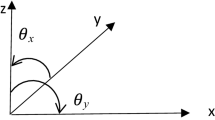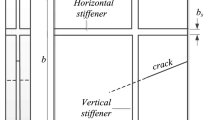Abstract
Based on the first-order shear deformation theory, a mesh-free Galerkin method for free vibration analysis of stiffened and un-stiffened folded plates and plate structures is presented in this paper. The folded plate or plate structure is modelled as a composite structure that consists of flat plates. The stiffness and mass matrices of the flat plates are derived based on the mesh-free formulation. To avoid the failure of direct superposition, a treatment is introduced to modify the stiffness and mass matrices. The global stiffness and mass matrices of the entire folded plate or plate structure are then obtained by superposing the modified stiffness and mass matrices of the flat plates. The analysis of the stiffened folded plates or plate structures proceeds in a similar fashion, as they are regarded as composite structures of stiffened and un-stiffened flat plates. The stiffness and mass matrices of the stiffened flat plates are also given by the mesh-free method. As no meshes are used in deriving the stiffness and mass matrices, the proposed method is more flexible in studying problems for which remeshing is inevitable with the finite element methods. Several numerical examples are computed with the proposed method to demonstrate its accuracy and convergence. The results show good agreement with the solutions that have been given by other researchers and ANSYS.
Similar content being viewed by others
References
Gaafar I (1954) Hipped plate analysis considering joint displacement. Trans Am Soc Civ Eng 119:743–784
Yitzhaki D (1958) Prismatic and cylindrical shell roofs. Haifa Science, Haifa
Yitzhaki D, Reiss M (1962) Analysis of folded plates. J Struct Div Am Soc Civ Eng 88:107–142
Whitney CS, Anderson BG, Birnbaum H (1959) Reinforced concrete folded plate construction. J Struct Div Am Soc Civ Eng 85:15–43
Goldberg JE, Leve HL (1957) Theory of prismatic folded plate structures. Int Assoc Bridge Struct Eng 17:59–86
Guha Niyogi A, Laha MK, Sinha PK (1999) Finite element vibration analysis of laminated composite folded plate structures. Shock Vib 6:273–283
Bar-Yoseph P, Hersckovitz I (1989) Analysis of folded plate structures. Thin Wall Struct 7:139–158
Bandyopadhyay JN, Laad PK (1990) Comparative analysis of folded plate structures. Comput Struct 36(2):291–296
Cheung YK (1969) Folded plate structures by finite strip method. J Struct Div Am Soc Civ Eng 95:2963–2979
Golley BW, Grice WA (1989) Prismatic folded plate analysis using finite strip-element. Comput Methods Appl Mech Eng 76:101–118
Eterovic AL, Godoy LA (1989) An exact-strip method for folded plate structures. Comput Struct 32(2):263–276
Ohga M, Shigematsu T, Kohigashi S (1991) Analysis of folded plate structures by a combined boundary element-transfer matrix method. Comput Struct 41(4):739–744
Liu WH, Huang CC (1992) Vibration analysis of folded plates. J Sound Vib 157(1):123–137
Perry B, Bar-Yoseph P, Rosenhouse G (1992) Rectangular hybrid shell element for analysing folded plate structures. Comput Struct 44(1–2):177–185
Duan M, Miyamoto Y (2002) Effective hybrid/mixed finite elements for folded-plate structures. J Eng Mech 128(2):202–208
Lucy LB (1977) A numerical approach to the testing of the fission hypothesis. Astron J 82:1013–1024
Lancaster P, Salkauskas K (1981) Surfaces generated by moving least-squares methods. Math Comput 37:141–158
Nayroles B, Touzot G, Villon P (1992) Generalizing the finite element method: Difference approximation and diffuse elements. Comput Mech 10:583–594
Belytschko T, Lu YY, Gu L (1994) Element-free Galerkin methods. Int J Numer Methods Eng 37:229–256
Liu WK, Jun S, Zhang YF (1995) Reproducing kernel particle methods. Int J Numer Methods Fluids 20:1081–1106
Chen JS, Pan C, Wu CT, Liu WK (1996) Reproducing kernel particle methods for large deformation analysis of nonlinear structures. Comput Methods Appl Mech Eng 139:195–227
Donning BM, Liu WK (1998) Meshless methods for shear-deformable beams and plates. Comput Methods Appl Mech Eng 152:47–71
Li S, Hao W, Liu WK (2000) Numerical simulations of large deformation of thin shell structures using meshfree methods. Comput Mech 25:102–116
Ren J, Liew KM (2002) Mesh-free method revisited: two new approaches for the treatment of essential boundary conditions. Int J Comput Eng Sci 3(2):219–233
Wang J, Liew KM, Tan MJ, Rajendran S (2002) Analysis of rectangular laminated composite plates via FSDT meshless method. Int J Mech Sci 44:1275–1293
Liew KM, Lim HK, Tan MJ, He XQ (2002) Analysis of laminated composite beams and plates with piezoelectric patches using the element-free Galerkin method. Comput Mech 29(6):486–497
Liew KM, Huang YQ, Reddy JN (2002) A hybird moving least squares and differential quadrature (MLSDQ) meshfree method. Int J Comput Eng Sci 3:1–12
Liew KM, Ng TY, Wu YC (2002) Meshfree method for large deformation analysis – a reproducing kernel particle approach. Eng Struct 24:543–551
Liew KM, Ng TY, Zhao X, Reddy JN (2002) Harmonic reproducing kernel particle method for free vibration analysis of rotating cylindrical shells. Comput Methods Appl Mech Eng 191: 4141–4157
Liew KM, Wu HY, Ng TY (2002) Meshless method for modeling of human proximal femur: Treatment of nonconvex boundaries and stress analysis. Comput Mech 28:390–400
Liew KM, Wu YC, Zou GP, Ng TY (2002) Elasto-plasticity revisited: Numerical analysis via reproducing kernel particle method and parametric quadratic programming. Int J Numer Methods Eng 55:669–683
Liew KM, Zhao X, Ng TY (2002) The element-free kp-Ritz method for vibration of laminated rotating cylindrical panels. Int J Struct Stab Dyn 2(4):523–558
Liew KM, Huang YQ (2003) Bending and buckling of thick symmetric rectangular laminates using the moving least-squares differential quadrature method. Int J Mech Sci 45:95–114
Liew KM, Huang YQ, Reddy JN (2003) Moving least square differential quadrature method and its application to the analysis of shear deformable plates. Int J Numer Methods Eng 56:2331–2351
Liew KM, Zou GP, Rajendran S (2003) A spline strip kernel particle method and its application to two-dimensional elasticity problems. Int J Numer Methods Eng 57:599–616
Liew KM, Huang YQ, Reddy JN (2003) Vibration analysis of symmetrically laminated plates based on FSDT using the moving least squares differential quadrature method. Comput Methods Appl Mech Eng 192:2203–2222
Liew KM, Chen XL (2004) Buckling of rectangular Mindlin plates subjected to partial in-plane edge loads using the radial point interpolation method. Int J Solids Struct 41:1677–1695
Liew KM, Ren J, Reddy JN (2005) Numerical simulation of the thermomechanical behaviour of shape memory alloys. Int J Numer Methods Eng 63(7):1014–1040
Irie T, Yamada G, Arora CP (1984) Free vibration of a cantilever folded plate. J Acoust Soc Am 76(6):1743–1748
Author information
Authors and Affiliations
Corresponding author
Rights and permissions
About this article
Cite this article
Peng, L.X., Kitipornchai, S. & Liew, K.M. Free Vibration Analysis of Folded Plate Structures by the FSDT Mesh-free Method. Comput Mech 39, 799–814 (2007). https://doi.org/10.1007/s00466-006-0070-9
Received:
Accepted:
Published:
Issue Date:
DOI: https://doi.org/10.1007/s00466-006-0070-9




